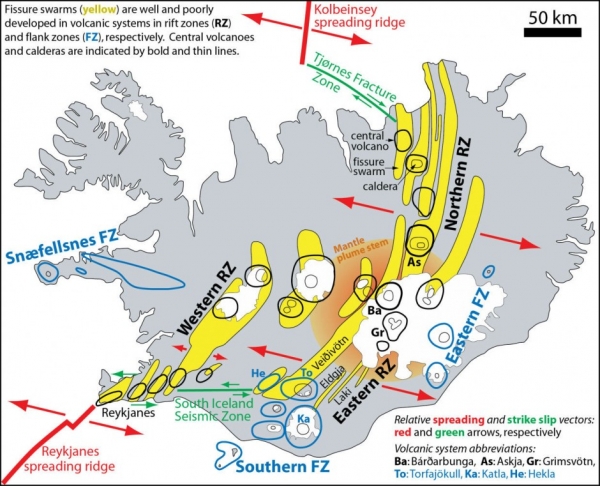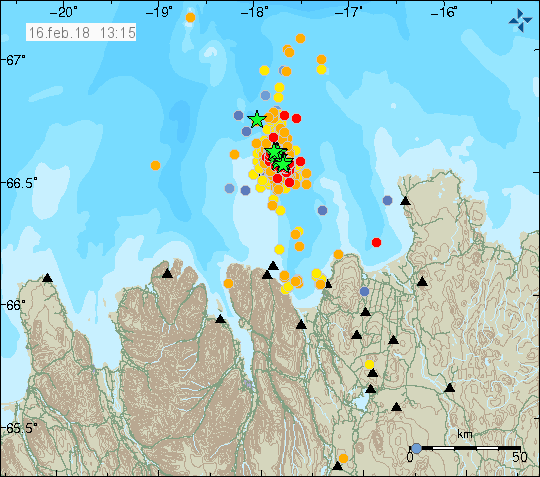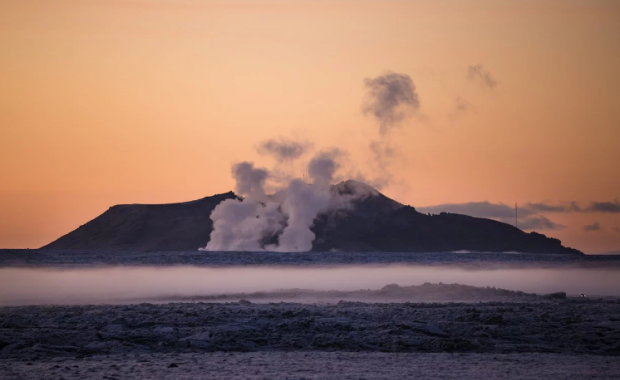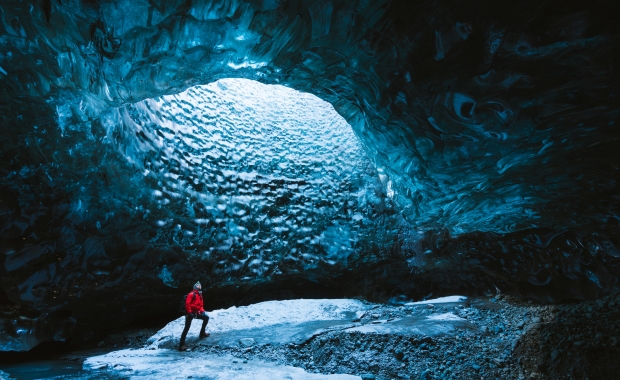The earthquake swarm which has been shaking Grímsey island, the small island 40 km (25 mi) off the north coast of Iceland, in the past two weeks shows no sign of slowing down. Several intense swarms have hit the small island since January. The current swarm, which counts 1,200 quakes, began on Wednesday and shows no sign of slowing down. Intense activity of this nature is likely the harbinger of something bigger, seismologists argue.
Read more: Grímsey earthquakes show no sign of slowing down: 1,200+ quakes in past 48 hours

The system could be overdue for a major earthquake. Major quakes appear to take place twice every 100 years. Two major quakes have been recorded in the past 110 years: A 1976 quake which was recorded as 6+ and a second 7+ quake which took place in 1910. Major quakes are frequently preceded by intense seismic activity.
No signs of an imminent eruption
The area around Grímsey island is known for high levels of geological activity, including volcanic eruptions. Since the area is off-shore not much is known about volcanic eruptions. The last known eruption in the area took place in 1867-68, south-east of Grímsey island.

Sigþrúður Ármannsdóttir, a seismologist at the Icelandic Meteorological Office told the local newspaper Morgunblaðið that the seismic readings do not show any signs of imminent volcanic activity. She added that it was not unusual to see hundreds of smaller quakes in earthquake swarms of this nature, and swarms with thousands of tremors are also well known, although they are not common.
While the swarm which has been shaking Grímsey island is not unheard of it is unusual, and a sign of significant geological events. Grímsey sits on the Tjörnes fracture zone, which is part of the North Atlantic Ridge, where the North American and Euroasian tectonic plates drift in opposite directions. The two plates drag past one another along the Tjörnes fracture zone, building up enormous energy which is then released in earthquakes.
Riddled with fractures and rifts
The epicenters of the quakes have been spread over a relatively large area north-east of Grímsey island, but the main center of activity appears to have been a submarine rift valley. Rift valleys are created where the tectonic plates drift in opposite directions, causing a part of the crust to sibside, creating a broad valley. Þingvellir National Park on the Golden Circle is located in such a rift valley.
A second seismologist at the Icelandic Meteorological Office told the local newspaper Fréttablaðið that the tremors recorded in past days seem to be caused by all kinds of movements in the earth's crust. The ocean floor around Grímsey is riddled with fractures and rifts. The simple picture of the the North American and Eurasian tectonic plates drifting in opposite directions is too simple. In some places they are dragged along each other and in others they are being dragged across one another. It's a mix of all kinds of movements. You can get a release of energy in one part of the system, which in turn adds to the pressure in a different part of the system.
A major earthquake imminent?

The most prominent expert in the Tjörnes Fracture zone, Sigurjón Jónsson, who is a professor of geophysics at the King Abdullah University of Science & Technology in Saudi Arabia, told the National Broadcasting Service RÚV that the earthquake swarm suggested the Tjörnes fracture zone was preparing for a major earthquake. Quakes in the system can exceed 7 on the Richter scale.
Sigurjón told RÚV that while the Tjörnes system is known for producing major quakes there have been no big events for decades. The last quake which exceeded 6 on the Richter scale took place in 1976. A massive 7+ earthquake took place in 1910. Its epicenter was somewhere to the south of the current activity Sigurjon told RÚV.
He told RÚV that while most swarms just run their course, intense swarms that continue for days suggest something more might be brewing. We are counting down to the next major quake off the north coast of Iceland. When we see these intense swarms the probability of something more happening rise. He pointed out that history suggests that major quakes in North Iceland are usually preceded by drawn out activity.
The earthquake swarm which has been shaking Grímsey island, the small island 40 km (25 mi) off the north coast of Iceland, in the past two weeks shows no sign of slowing down. Several intense swarms have hit the small island since January. The current swarm, which counts 1,200 quakes, began on Wednesday and shows no sign of slowing down. Intense activity of this nature is likely the harbinger of something bigger, seismologists argue.
Read more: Grímsey earthquakes show no sign of slowing down: 1,200+ quakes in past 48 hours

The system could be overdue for a major earthquake. Major quakes appear to take place twice every 100 years. Two major quakes have been recorded in the past 110 years: A 1976 quake which was recorded as 6+ and a second 7+ quake which took place in 1910. Major quakes are frequently preceded by intense seismic activity.
No signs of an imminent eruption
The area around Grímsey island is known for high levels of geological activity, including volcanic eruptions. Since the area is off-shore not much is known about volcanic eruptions. The last known eruption in the area took place in 1867-68, south-east of Grímsey island.

Sigþrúður Ármannsdóttir, a seismologist at the Icelandic Meteorological Office told the local newspaper Morgunblaðið that the seismic readings do not show any signs of imminent volcanic activity. She added that it was not unusual to see hundreds of smaller quakes in earthquake swarms of this nature, and swarms with thousands of tremors are also well known, although they are not common.
While the swarm which has been shaking Grímsey island is not unheard of it is unusual, and a sign of significant geological events. Grímsey sits on the Tjörnes fracture zone, which is part of the North Atlantic Ridge, where the North American and Euroasian tectonic plates drift in opposite directions. The two plates drag past one another along the Tjörnes fracture zone, building up enormous energy which is then released in earthquakes.
Riddled with fractures and rifts
The epicenters of the quakes have been spread over a relatively large area north-east of Grímsey island, but the main center of activity appears to have been a submarine rift valley. Rift valleys are created where the tectonic plates drift in opposite directions, causing a part of the crust to sibside, creating a broad valley. Þingvellir National Park on the Golden Circle is located in such a rift valley.
A second seismologist at the Icelandic Meteorological Office told the local newspaper Fréttablaðið that the tremors recorded in past days seem to be caused by all kinds of movements in the earth's crust. The ocean floor around Grímsey is riddled with fractures and rifts. The simple picture of the the North American and Eurasian tectonic plates drifting in opposite directions is too simple. In some places they are dragged along each other and in others they are being dragged across one another. It's a mix of all kinds of movements. You can get a release of energy in one part of the system, which in turn adds to the pressure in a different part of the system.
A major earthquake imminent?

The most prominent expert in the Tjörnes Fracture zone, Sigurjón Jónsson, who is a professor of geophysics at the King Abdullah University of Science & Technology in Saudi Arabia, told the National Broadcasting Service RÚV that the earthquake swarm suggested the Tjörnes fracture zone was preparing for a major earthquake. Quakes in the system can exceed 7 on the Richter scale.
Sigurjón told RÚV that while the Tjörnes system is known for producing major quakes there have been no big events for decades. The last quake which exceeded 6 on the Richter scale took place in 1976. A massive 7+ earthquake took place in 1910. Its epicenter was somewhere to the south of the current activity Sigurjon told RÚV.
He told RÚV that while most swarms just run their course, intense swarms that continue for days suggest something more might be brewing. We are counting down to the next major quake off the north coast of Iceland. When we see these intense swarms the probability of something more happening rise. He pointed out that history suggests that major quakes in North Iceland are usually preceded by drawn out activity.







